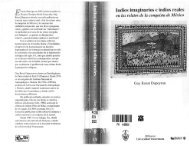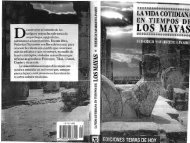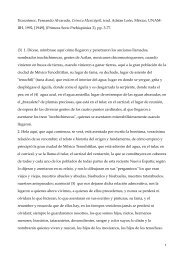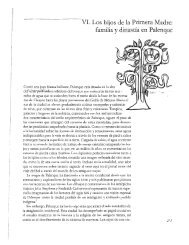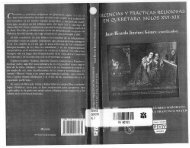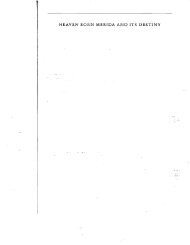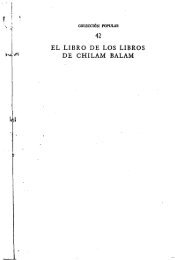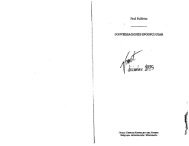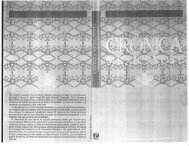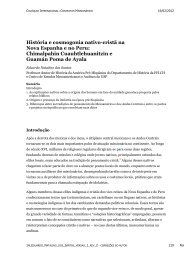1 - Histomesoamericana
1 - Histomesoamericana
1 - Histomesoamericana
Create successful ePaper yourself
Turn your PDF publications into a flip-book with our unique Google optimized e-Paper software.
INTRODUCTION XÍX<br />
The Itza took their prophecies very seriously indeed. One group which<br />
had fled south after the fall of Mayapan and resettled at Tayasal on Lake<br />
Peten rejected as calendrically premature the efforts of Cortés in 13 Ahau<br />
(1539) and of Fuensálida and Órbita in 3 Ahau (1618) to Christianize them.<br />
But when the appropriate katun 8 Ahau approached (1697-1717) they<br />
knew the time was right, and in 1695 they sent an embassy to Merida to<br />
ask the governor to convert them. Obliging with their usual obtuse alacrity,<br />
the Spaniards arrived before 8 Ahau began and forced the Indians into<br />
armed opposition. But true to the prophecy it was in 8 Ahau that Tayasal<br />
was conquered. (For a detailed documentation of this event, see Bricker<br />
1981.)<br />
In 1752, five years before the end of katun 4 Ahau, the Itza resolved<br />
upon another calendrical revision. It happened that in that year the name<br />
day of the katun fell on the second day of the Mayan year. Furthermore,<br />
the Itza cycle was due to end two katuns later, in 13 Ahau, with apocalyptic<br />
implications. The priests calculated that, if they redefined the<br />
katun as a period of twenty-four years instead of twenty tuns, they could<br />
always celebrate the seating of the katun on its eve, on the Mayan new<br />
year. If they further redefined the cycle [may] as twenty-four such katuns<br />
beginning from the 11 Ahau of the conquest, it would not end until 2088,<br />
a distinct advantage over surrendering legitimacy in 1776. Katun 4 Ahau<br />
was therefore reseated in 1752, hence lasting for thirty-nine years, and<br />
Valladolid (Zaciapan) was made the seat of the new cycle and also the seat<br />
of katun 2 Ahau (1776-1800). Just as the Mayapan calendar of 1539 adjusted<br />
Mayan terminal dating to Mexican initial dating, the Valladolid<br />
calendar of 1752 adjusted the Mayan calendar to the Julian one. The cost<br />
was the final abandonment of the true katun and hence of the Classic<br />
Mayan Long Count dating (see the appendix).<br />
Despite the brilliance of the Valladolid calendar, there may well have<br />
been Mayas, including Itzas, who remained uneasy about 13 Ahau, the<br />
traditional end of the Itza cycle. One such may be responsible for the<br />
aberrant fifty-two-year calendar of chapter 41, which appears to have been<br />
designed in 1758 and may be identified with Coba. It retains the yearbearers<br />
of the Mayapan calendar but alters their numeral coefficients by<br />
twenty-one years (presumably the twenty-one years between the beginning<br />
of 4 Ahau in 1737 and the writing of chapter 41 in 1758). There is no<br />
evidence that this calendar was adopted by anyone but its author. Other<br />
similar experiments occurred sporadically in Mayan history: see the<br />
twenty-eight-year cycle of the early seventeenth century (lines 3531 ff.). A<br />
further experiment of this type may be implied by the marginal notes to<br />
chapter 24, probably added in 9 Ahau (1848-1872), which give Type I<br />
yearbearers and an ecclesiastical calendar attuned to the Gregorian one<br />
(see the appendix and Satterthwaite 1965).<br />
The final chapter of the Tizimin continues to identify itself as Itza in<br />
the very last line. But this is a new Itza cycle that is initiated in 1824—or<br />
so its author appears to believe. It claims the mantle of all the gods, the<br />
privilege of prophetic vision, the tradition of the Spokesmen of the Jaguar<br />
Priest of the katun, and the aegis of the 4 Gods, yearbearers and rain<br />
giants of the four directions. It honors Mayapan and Christianity. And it<br />
predicts and records the ending of tribute to the Spaniards as well as the<br />
Caste War.



